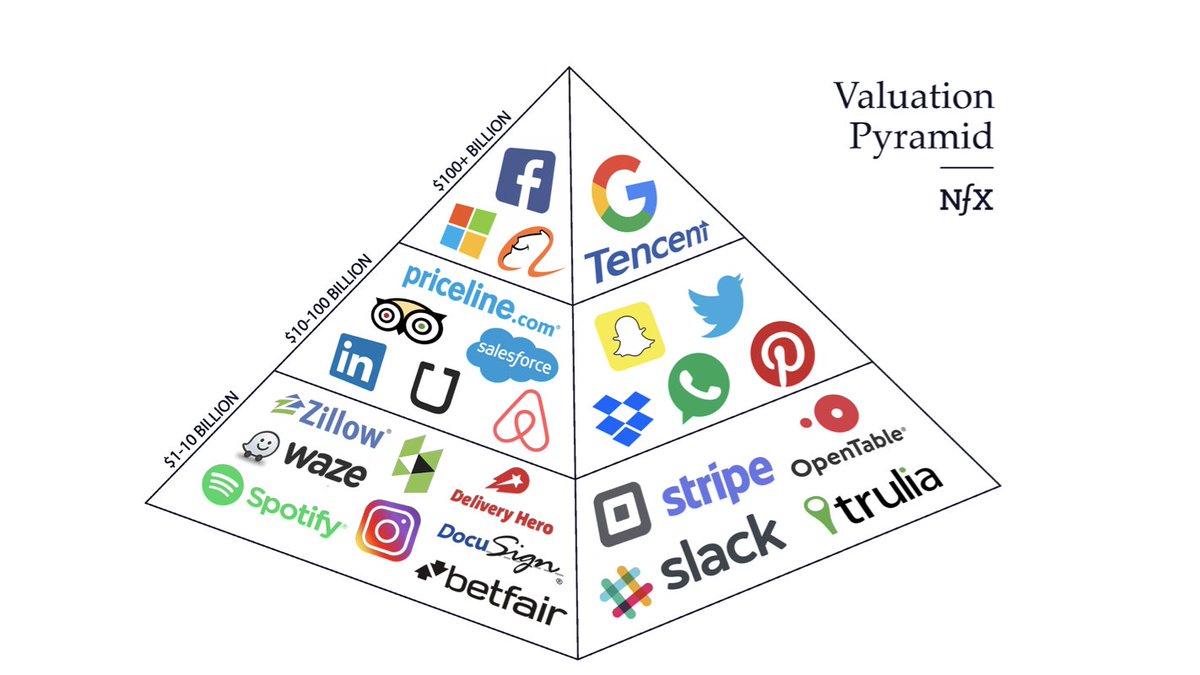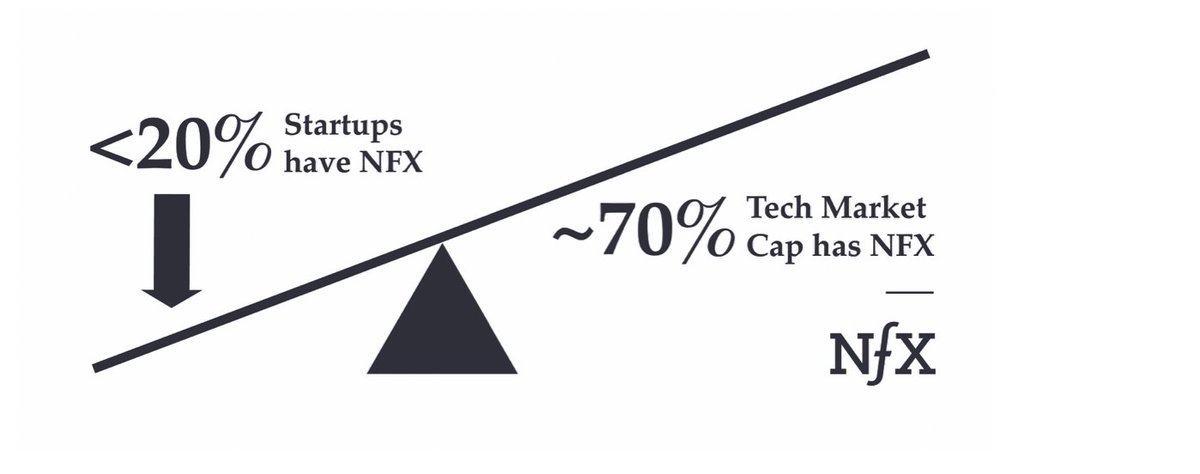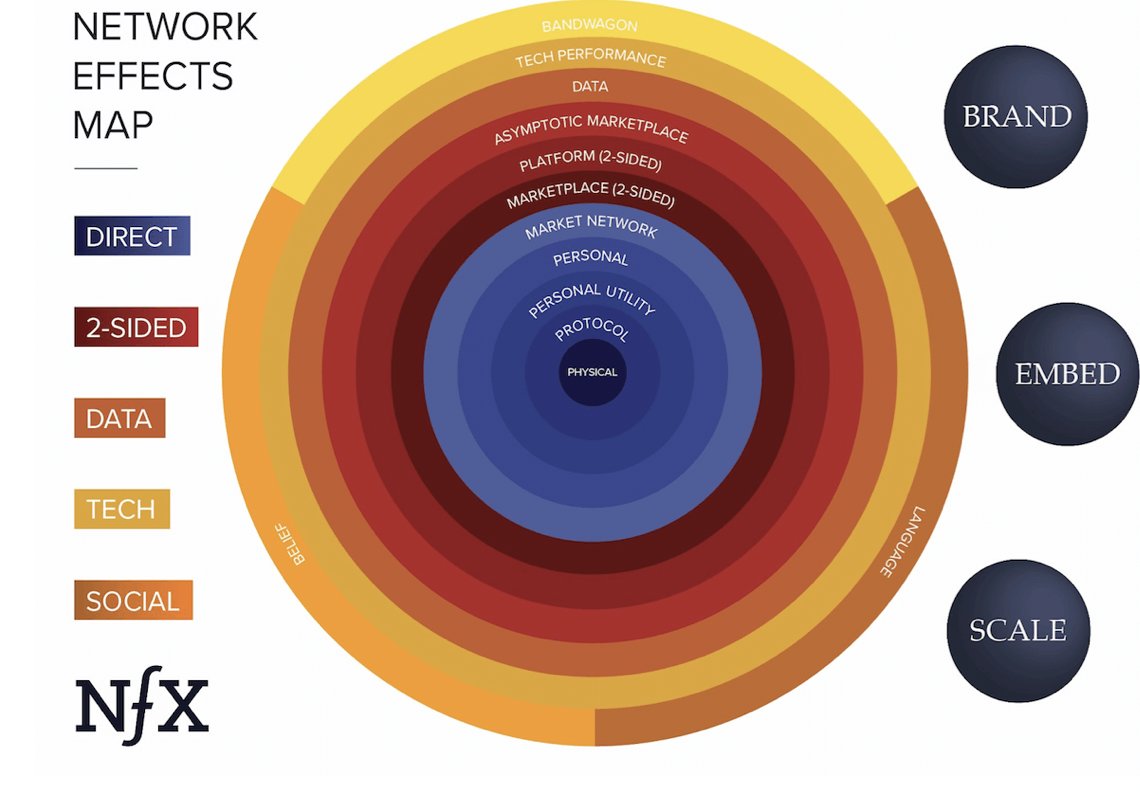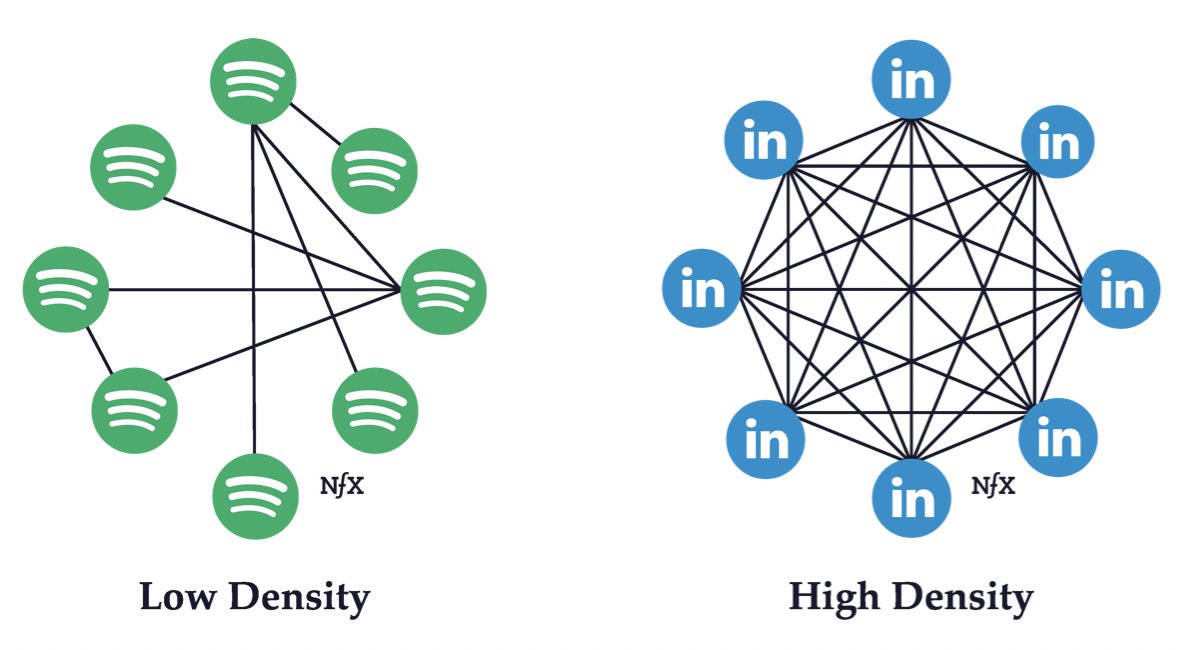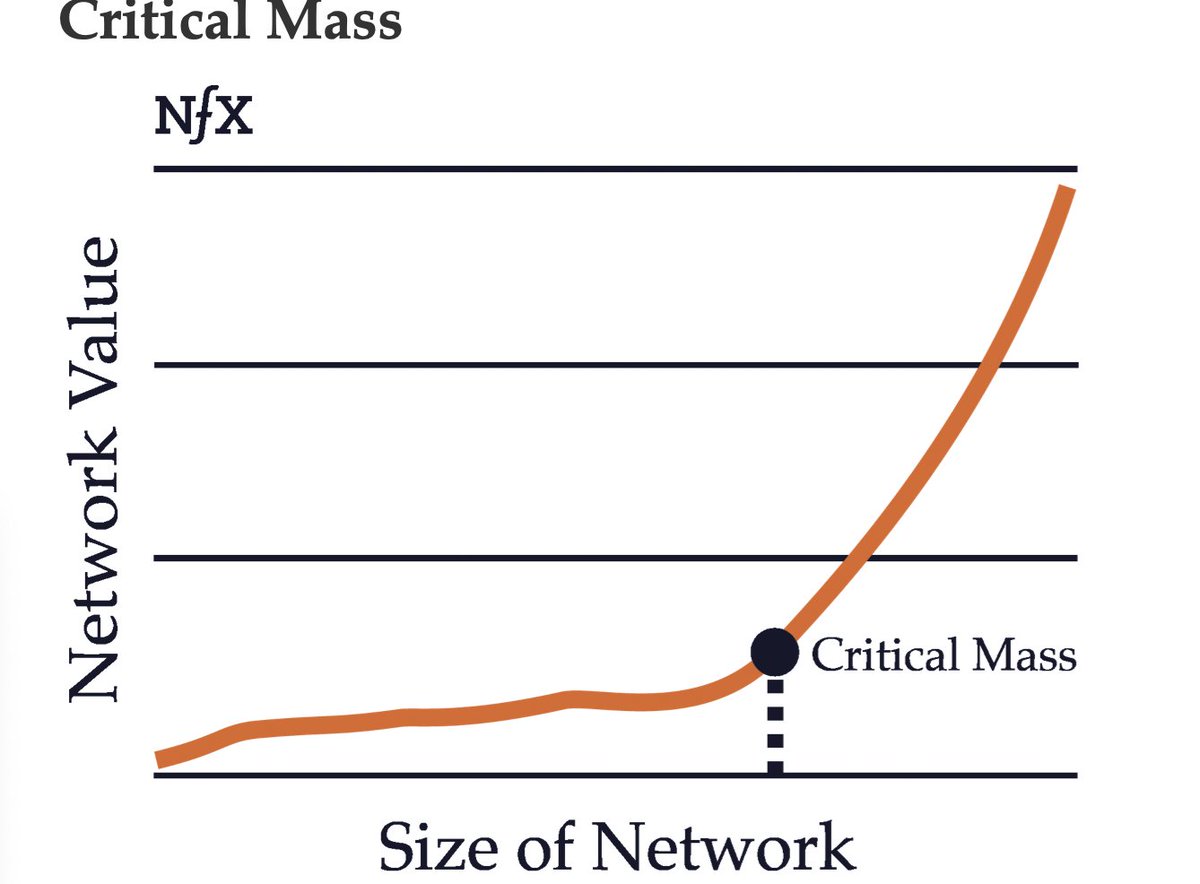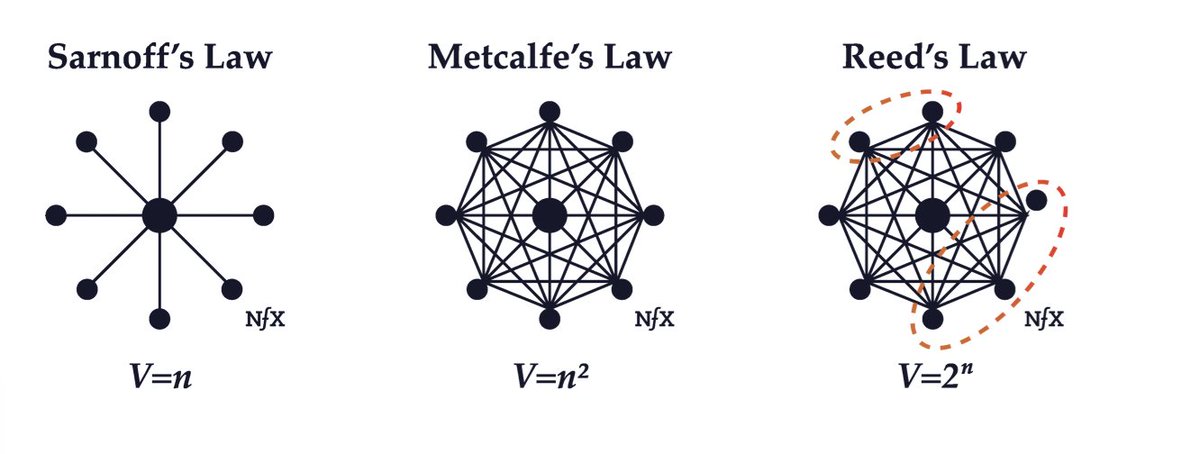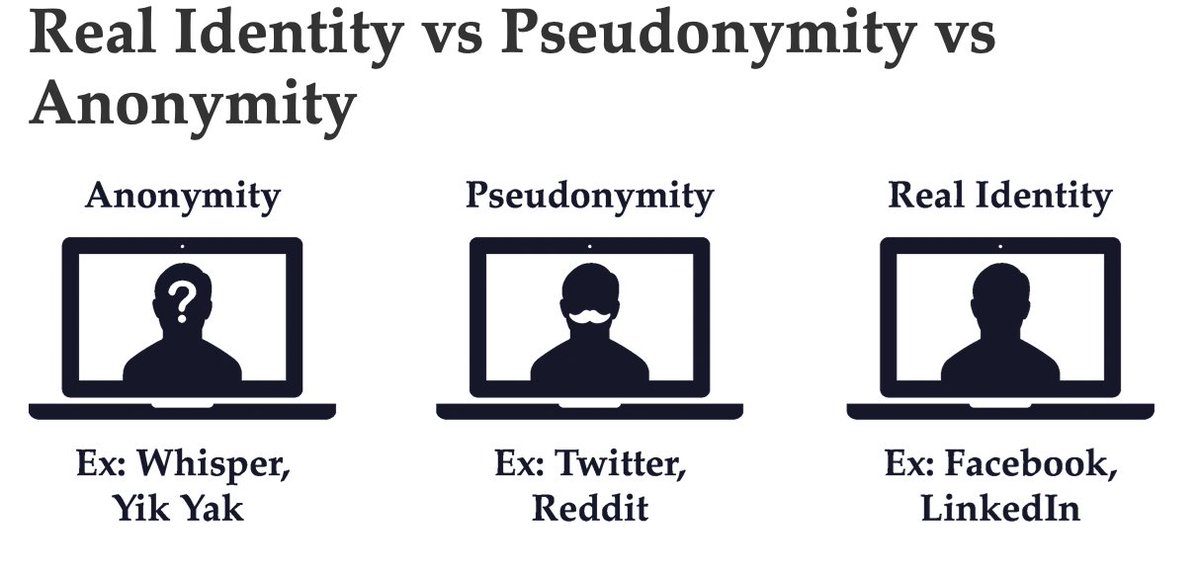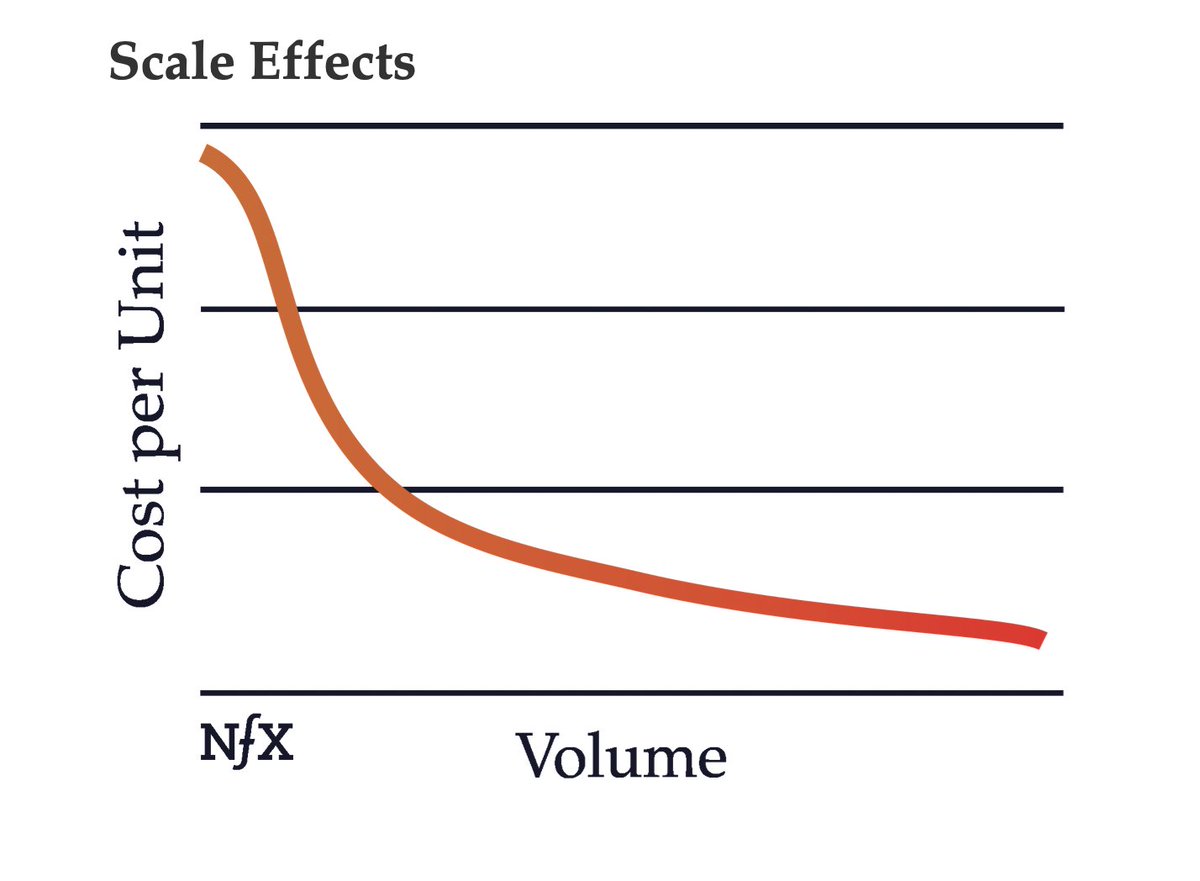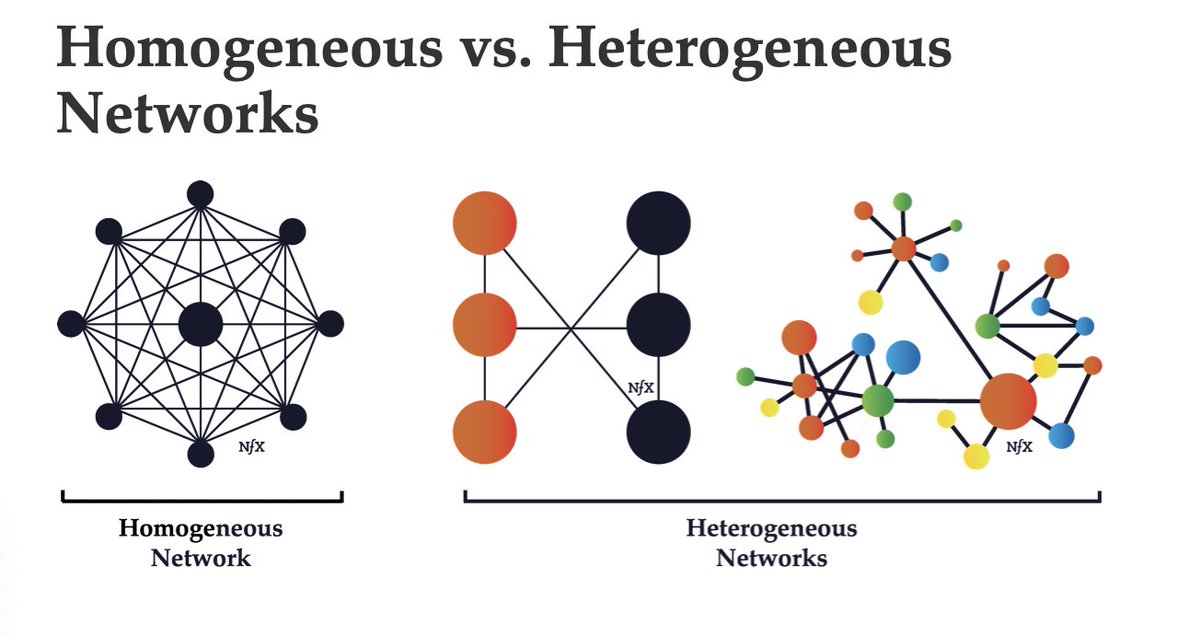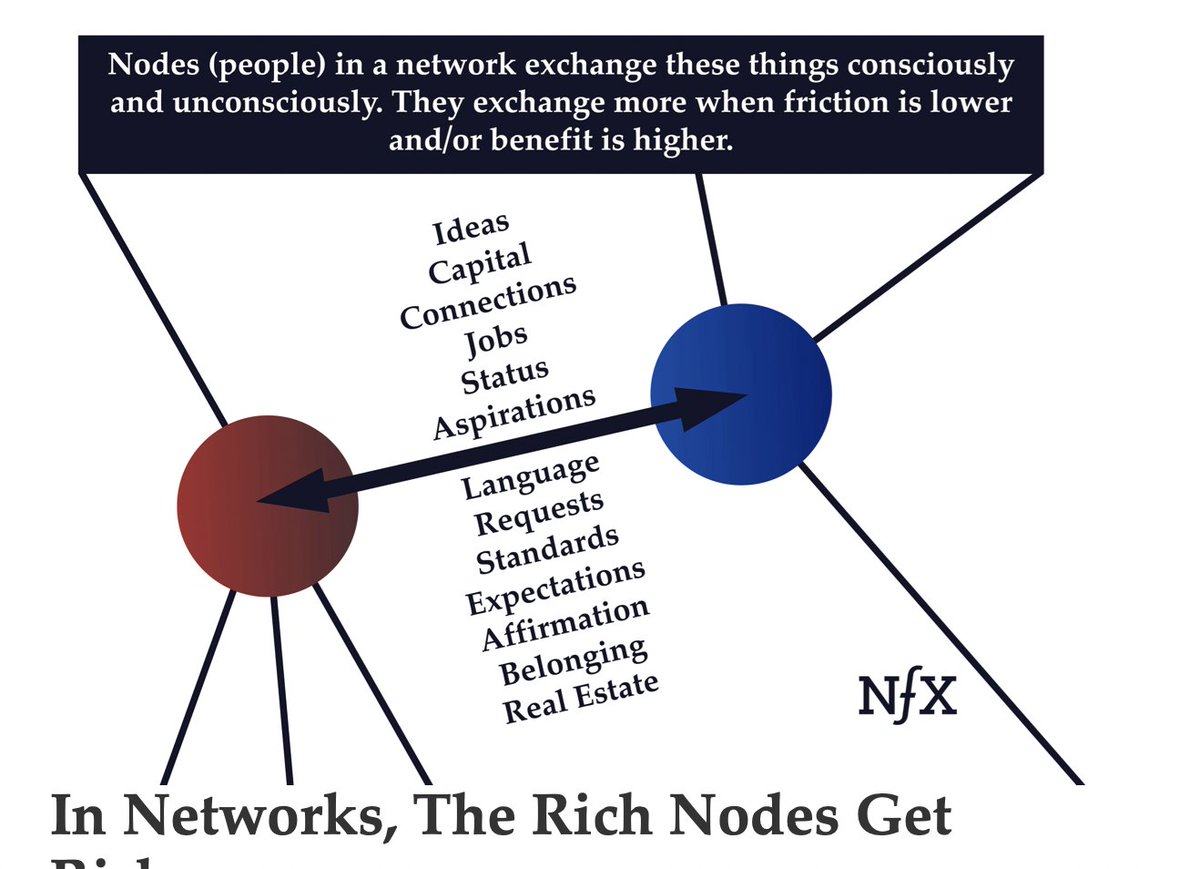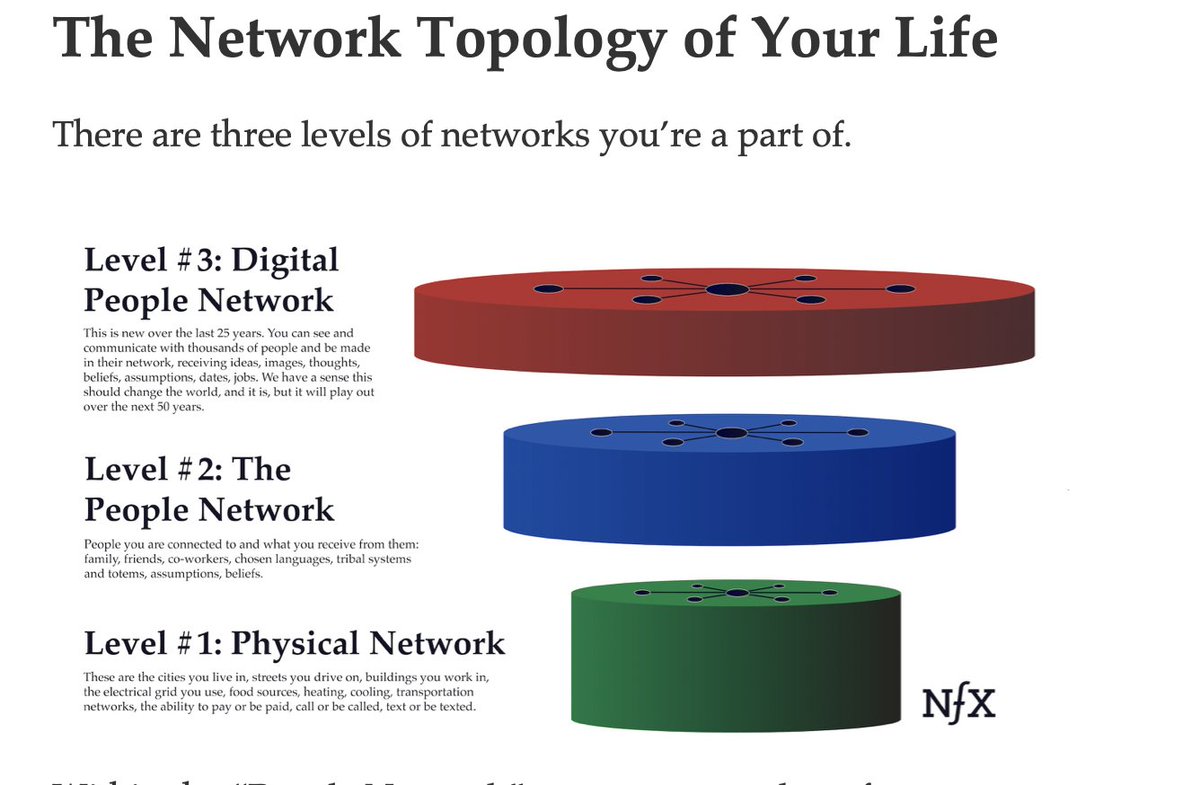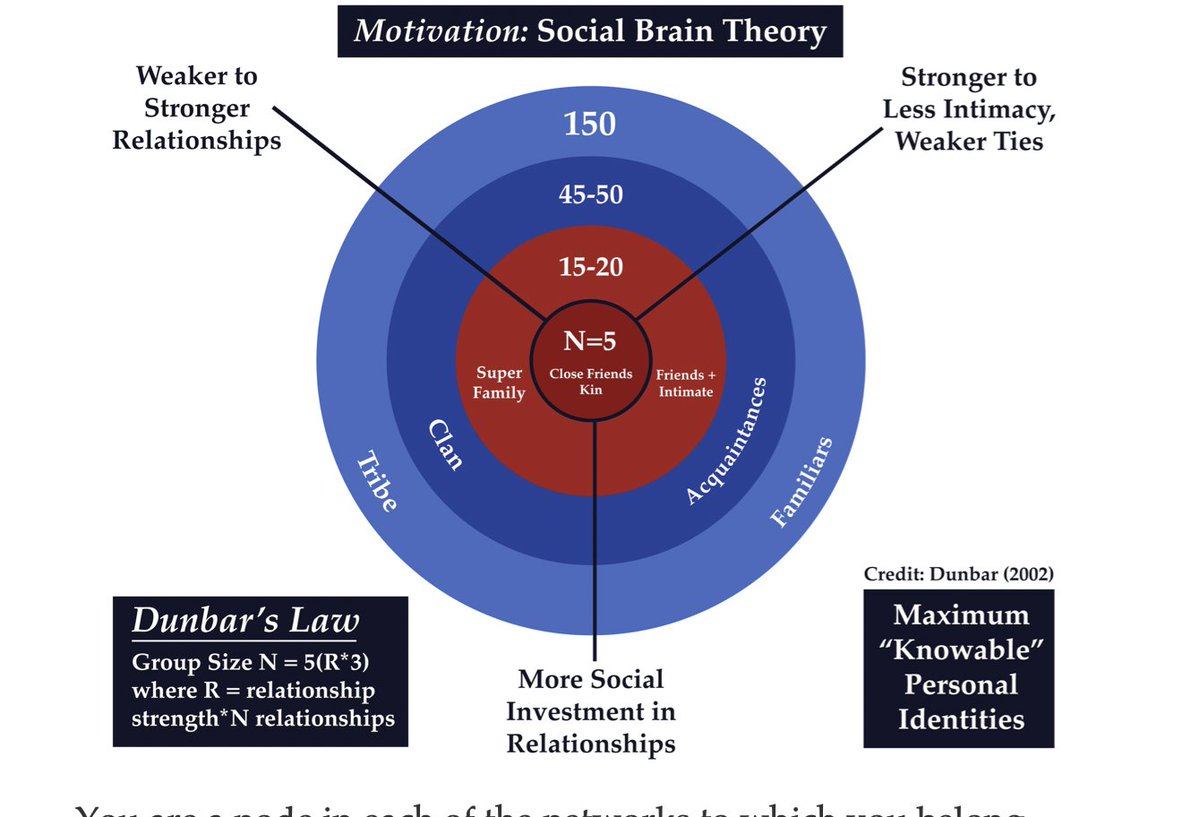High-level overview on network effects (nfx):
- Frameworks for thinking about them
- Different kinds of nfx
- Other forms of defensibility
- Addressing bottlenecks to nfx
- Misconceptions around nfx
References @JamesCurrier @anuhariharan @ljin18 @DCoolican (h/t @NFX for photos)
- Frameworks for thinking about them
- Different kinds of nfx
- Other forms of defensibility
- Addressing bottlenecks to nfx
- Misconceptions around nfx
References @JamesCurrier @anuhariharan @ljin18 @DCoolican (h/t @NFX for photos)
A product has network effects when every new user makes the product more valuable to every other user.
In other words, it becomes more valuable to its users as more people use it.
Why are they important?
Most huge tech companies have network effects. Best form of defensibility
In other words, it becomes more valuable to its users as more people use it.
Why are they important?
Most huge tech companies have network effects. Best form of defensibility
Network effects lead to high engagement/repeat rates & higher margins
By creating barriers to exit for existing users, you create barriers to entry for new companies
Difference between marketplaces & D2C: They get easier rather than harder as you scale https://twitter.com/eriktorenberg/status/1242510927544463362?s=20">https://twitter.com/eriktoren...
By creating barriers to exit for existing users, you create barriers to entry for new companies
Difference between marketplaces & D2C: They get easier rather than harder as you scale https://twitter.com/eriktorenberg/status/1242510927544463362?s=20">https://twitter.com/eriktoren...
Network effects aren& #39;t viral effects.
Viral effects are about user growth.
Network effects are about defensibility
Viral effects get users & customers on your site.
Network effects keep them coming back—and using/spending more as they do.
Viral effects are about user growth.
Network effects are about defensibility
Viral effects get users & customers on your site.
Network effects keep them coming back—and using/spending more as they do.
"13 kinds of network effects:
1. Physical (e.g. landline telephones)
2. Protocol (e.g. Ethernet)
3. Personal Utility (e.g. iMessage, WhatsApp)
4. Personal (e.g. Facebook)
5. Market Network (e.g. HoneyBook, AngelList)
6. Marketplace (e.g. eBay, Craigslist)
7. Platform (e.g. iOS)"
1. Physical (e.g. landline telephones)
2. Protocol (e.g. Ethernet)
3. Personal Utility (e.g. iMessage, WhatsApp)
4. Personal (e.g. Facebook)
5. Market Network (e.g. HoneyBook, AngelList)
6. Marketplace (e.g. eBay, Craigslist)
7. Platform (e.g. iOS)"
"13 network effects continued:
8. Asymptotic Marketplace (e.g. Uber, Lyft)
9. Data (e.g. Waze, Yelp!)
10. Tech Performance (e.g. Bittorrent,Skype)
11. Language (e.g. Google, Xerox)
12. Belief (currencies, religions)
13. Bandwagon (e.g. Slack, Apple)" https://www.nfx.com/post/network-effects-manual/">https://www.nfx.com/post/netw...
8. Asymptotic Marketplace (e.g. Uber, Lyft)
9. Data (e.g. Waze, Yelp!)
10. Tech Performance (e.g. Bittorrent,Skype)
11. Language (e.g. Google, Xerox)
12. Belief (currencies, religions)
13. Bandwagon (e.g. Slack, Apple)" https://www.nfx.com/post/network-effects-manual/">https://www.nfx.com/post/netw...
Typically, the higher the density of a network, the more powerful its network effects are.
Focus on the "red-hot-center" of a network or marketplace — the densest, highest activity part.
Focus on the product features & language to get other users to behave more like that group.
Focus on the "red-hot-center" of a network or marketplace — the densest, highest activity part.
Focus on the product features & language to get other users to behave more like that group.
Critical mass: The critical mass of a network refers to the point at which the value produced by the network exceeds the value of the product itself and of competing products. This can happen at different times depending on the type of a network.
Evolution of network effects:
1st: Broadcast: network value is proportional to its viewers (e.g Yahoo)
2nd: Metcalfe& #39;s law: value is proportional to N squared (eg FB)
3rd: Reed’s law: value can scale exponentially b/c of subgroups formed (e.g vertical networks)
1st: Broadcast: network value is proportional to its viewers (e.g Yahoo)
2nd: Metcalfe& #39;s law: value is proportional to N squared (eg FB)
3rd: Reed’s law: value can scale exponentially b/c of subgroups formed (e.g vertical networks)
@sarahtavel stresses importance of users completing "Core Actions"
- The more you use the product, the better the experience gets
- The more you use the product, the harder it is to leave
- Conversely, you don& #39;t want your product to be easy to switch https://medium.com/@sarahtavel/the-hierarchy-of-engagement-expanded-648329d60804">https://medium.com/@sarahtav...
- The more you use the product, the better the experience gets
- The more you use the product, the harder it is to leave
- Conversely, you don& #39;t want your product to be easy to switch https://medium.com/@sarahtavel/the-hierarchy-of-engagement-expanded-648329d60804">https://medium.com/@sarahtav...
Real Identity strengthens network effects.
People say Facebook beat Myspace because FB leveraged real identity.
Per Sarah& #39;s theory above, when you put your real name onto some social economy ("followers" "friends"), it becomes harder to leave.
People say Facebook beat Myspace because FB leveraged real identity.
Per Sarah& #39;s theory above, when you put your real name onto some social economy ("followers" "friends"), it becomes harder to leave.
Network effects are important because they are the best form of defensibility, and thus value creation, in the digital world (the three other major defensibilities are brand, embedding, and scale).
Most big businesses have network effects, but not all.
Most big businesses have network effects, but not all.
Defensibility without network effects:
- Scale enables negotiating leverage (e.g MoviePass), amortization of fixed assets (Netflix), & product density (LimeBike)
- Brand (e.g. Coinbase)
- High switching cost b/c embedding, habit, or personal data https://medium.com/@mheiman/beyond-network-effects-digging-moats-in-non-networked-products-b6c10de43a7b">https://medium.com/@mheiman/...
- Scale enables negotiating leverage (e.g MoviePass), amortization of fixed assets (Netflix), & product density (LimeBike)
- Brand (e.g. Coinbase)
- High switching cost b/c embedding, habit, or personal data https://medium.com/@mheiman/beyond-network-effects-digging-moats-in-non-networked-products-b6c10de43a7b">https://medium.com/@mheiman/...
Economies of scale: As well-run companies get bigger, their per unit production costs get cheaper
In other words, more users means greater volume, which means cheaper prices from suppliers, which means lower prices for customers, which means higher conversion rates for ads, etc
In other words, more users means greater volume, which means cheaper prices from suppliers, which means lower prices for customers, which means higher conversion rates for ads, etc
Hidden network effects
- Slow Networks: companies where network effects take a while to build (e.g. Lambda School, YC)
- Latent Networks: companies that first focus on single player experiences before introducing multi-player (e.g. Roam Research) https://a16z.com/2019/07/29/hidden-networks-effects/">https://a16z.com/2019/07/2...
- Slow Networks: companies where network effects take a while to build (e.g. Lambda School, YC)
- Latent Networks: companies that first focus on single player experiences before introducing multi-player (e.g. Roam Research) https://a16z.com/2019/07/29/hidden-networks-effects/">https://a16z.com/2019/07/2...
Network effects that peak
Social Networks: after a certain point, turns into reverse network effect
Ridesharing: Once multiple platforms hit relative liquidity, users don& #39;t care (supply commoditized)
Other reverse nfx: https://twitter.com/eriktorenberg/status/1133105603054694400?s=20
https://twitter.com/eriktoren... href=" https://a16z.com/2018/12/13/network-effects-dynamics-in-practice/">https://a16z.com/2018/12/1...
Social Networks: after a certain point, turns into reverse network effect
Ridesharing: Once multiple platforms hit relative liquidity, users don& #39;t care (supply commoditized)
Other reverse nfx: https://twitter.com/eriktorenberg/status/1133105603054694400?s=20
Marketplaces should reduce search costs & make matching easier.
When it doesn& #39;t, each additional user causes more challenge in discovery, resulting in decision fatigue (e.g dating apps)
When it doesn& #39;t, each additional user causes more challenge in discovery, resulting in decision fatigue (e.g dating apps)
“Homogeneous supply” marketplaces hit an asymptote in nfx, where value to users plateaus w greater market depth (LimeBike)
For heterogeneous marketplaces, there is no asymptote because every node on the supply side is different and potentially can add greater value (e.g. Airbnb)
For heterogeneous marketplaces, there is no asymptote because every node on the supply side is different and potentially can add greater value (e.g. Airbnb)
How to avoid multi-tenanting (users using multiple products, e.g. Lyft & Uber):
Layer on functionality that can obviate the need for another product. (e.g. Uber layering on Uber Eats to prevent Lyft Growth, FB layering on stories to stymie Snap& #39;s growth) https://a16z.com/2018/12/13/16-metrics-network-effects/">https://a16z.com/2018/12/1...
Layer on functionality that can obviate the need for another product. (e.g. Uber layering on Uber Eats to prevent Lyft Growth, FB layering on stories to stymie Snap& #39;s growth) https://a16z.com/2018/12/13/16-metrics-network-effects/">https://a16z.com/2018/12/1...
Data + network effects ≠ data network effects
Sometimes more data is worse: instead of getting stronger, the data moat erodes as the corpus grows
It& #39;s a data network effects when data improves the algorithm that improves the user experience. https://a16z.com/2019/05/09/data-network-effects-moats/">https://a16z.com/2019/05/0...
Sometimes more data is worse: instead of getting stronger, the data moat erodes as the corpus grows
It& #39;s a data network effects when data improves the algorithm that improves the user experience. https://a16z.com/2019/05/09/data-network-effects-moats/">https://a16z.com/2019/05/0...
Most data doesn’t produce a real data network effect, and most data network effects aren’t that powerful even once established.
A data network effect is when a product’s value grows as a result of more usage via the accretion of data. https://www.nfx.com/post/truth-about-data-network-effects/">https://www.nfx.com/post/trut...
A data network effect is when a product’s value grows as a result of more usage via the accretion of data. https://www.nfx.com/post/truth-about-data-network-effects/">https://www.nfx.com/post/trut...
Network effects even determine your life:
- who you marry
- who your friends are
- what job you choose
- where you live
https://www.nfx.com/post/your-life-network-effects/">https://www.nfx.com/post/your...
- who you marry
- who your friends are
- what job you choose
- where you live
https://www.nfx.com/post/your-life-network-effects/">https://www.nfx.com/post/your...

 Read on Twitter
Read on Twitter